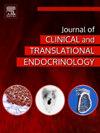2型糖尿病患者总血清和生物活性血清硬化蛋白水平与骨代谢的关系
IF 3.3
Q1 ENDOCRINOLOGY & METABOLISM
Journal of Clinical and Translational Endocrinology
Pub Date : 2025-04-08
DOI:10.1016/j.jcte.2025.100393
引用次数: 0
摘要
研究背景:在2型糖尿病(T2DM)患者中,硬化汀与骨转换减少有关。骨转换标志物(BTMs)和骨矿物质密度(BMD)之间的关系尚不清楚。我们研究了三种不同测定法测量的T2DM患者总硬化蛋白和生物活性硬化蛋白与btm和BMD之间的关系,并与健康对照进行了比较。方法对瑞士横断面多中心diabos研究的基线数据进行分析。采用三种不同的基于elisa的硬化蛋白测定法(sclerostin Biomedica、sclerostin生物活性Biomedica和sclerostin hsTECO)测定血清总硬化蛋白和生物活性硬化蛋白水平。T2DM患者和对照组的硬化蛋白水平与BTMs和BMD相关。结果分析了78名患有T2DM的男性和绝经后女性以及37名对照组(50-75岁)的数据。根据估计的肾小球滤过率(eGFR)调整后的血清硬化蛋白水平在T2DM患者中均高于对照组。在性别亚组分析中,男性T2DM患者的生物活性硬化蛋白水平仍显著升高(T2DM: 106.8±39.9 pmol/L;对照组为88.3±21.3 pmol/L, p = 0.03)。单因素分析显示,年龄、eGFR、糖化血红蛋白A1c和糖尿病病程与所有硬化蛋白检测结果具有一致的显著相关性。然而,在多变量分析中,eGFR仍然是血清硬化蛋白水平的唯一重要决定因素。T2DM患者的硬化蛋白水平与BMD呈显著正相关,而与BTMs无显著相关。结论:我们证明了生物活性血清硬化蛋白与T2DM患者所有测量部位的骨密度显著正相关,这可能支持其在评估该人群骨脆弱性方面的实用性。本文章由计算机程序翻译,如有差异,请以英文原文为准。
Association of total and bioactive serum sclerostin levels with bone metabolism in type 2 diabetes mellitus
Background
Sclerostin has been associated with decreased bone turnover in patients with type 2 diabetes mellitus (T2DM). The relationship with bone turnover markers (BTMs) and bone mineral density (BMD) remains unclear. We investigate the relationship between total and bioactive sclerostin measured by three different assays with BTMs and BMD in patients with T2DM compared to healthy controls.
Methods
Baseline data from the cross-sectional multicenter DiabOS-study in Switzerland were analysed. Total and bioactive serum sclerostin levels were measured using three different ELISA-based sclerostin assays (Sclerostin Biomedica, Sclerostin bioactive Biomedica and Sclerostin hsTECO). Sclerostin levels in patients with T2DM and controls were correlated with BTMs and BMD.
Results
Data were analysed from 78 men and postmenopausal women with T2DM and 37 controls (aged 50–75 years). Serum sclerostin levels, adjusted for estimated glomerular filtration rate (eGFR), were higher in patients with T2DM compared to controls with all three assays. In a gender subgroup analysis, bioactive sclerostin levels remained significantly elevated in men with T2DM (T2DM, 106.8 ± 39.9 pmol/L; controls, 88.3 ± 21.3 pmol/L, p = 0.03).
Univariate analysis showed consistent significant correlations with all sclerostin assays for age, eGFR, glycated hemoglobin A1c and diabetes duration. However, in multivariate analysis, eGFR remained the only significant determinant of serum sclerostin levels. Sclerostin levels in patients with T2DM showed significant positive correlations with BMD but no significant correlations with BTMs.
Conclusions
We demonstrate a significant positive association of bioactive serum sclerostin with BMD at all measured sites in patients with T2DM, which may support its utility in the assessment of bone fragility in this population.
求助全文
通过发布文献求助,成功后即可免费获取论文全文。
去求助
来源期刊

Journal of Clinical and Translational Endocrinology
ENDOCRINOLOGY & METABOLISM-
CiteScore
6.10
自引率
0.00%
发文量
24
审稿时长
16 weeks
 求助内容:
求助内容: 应助结果提醒方式:
应助结果提醒方式:


